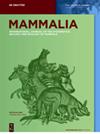Novel insights into red deer (Cervus elaphus) habitat use and suitability in human-dominated versus near-natural landscapes
IF 0.8
4区 生物学
Q3 ZOOLOGY
引用次数: 0
Abstract
Red deer populations, once extirpated in large parts of Europe, have recovered over the last century in many regions. In Switzerland, primarily inhabiting mountain forests, they have recently started to expand into human-dominated lowland landscapes. To study their habitat selection, we analyzed day- and nighttime positions of 15 GPS-collared red deer. Our results show that during daytime, all animals generally preferred forests; open land was mainly used at night. In summer and fall, some lowland individuals deviated from this pattern and used agricultural crops as daytime retreats. Human settlements were often avoided in the lowlands. Day-site selection in the lowlands occurred irrespective of the distance to trails and the probability of being accessed by humans, in contrast to the pattern observed in the mountains. At night, red deer preferred forest edges and open land. In the lowlands, human settlements were avoided. Trails and transport infrastructures had a marginal influence at night. Our study confirmed a high behavioral plasticity of red deer. The use of daytime retreats close to trails and in high-standing crops represent major extensions of their behavior. Our habitat models indicate that there is ample suitable habitat in the lowlands, which is of major relevance for their management.红鹿(Cervus elaphus)栖息地使用和适宜性在人类主导景观与近自然景观中的新见解
红鹿曾一度在欧洲大部分地区灭绝,但在上个世纪,许多地区的红鹿数量已经恢复。在瑞士,红鹿主要栖息在山林中,最近开始向以人类为主的低地扩展。为了研究赤鹿对栖息地的选择,我们分析了 15 只戴有 GPS 耳环的赤鹿在白天和夜间的位置。结果表明,白天,所有动物一般都喜欢森林;夜间则主要选择开阔地。在夏季和秋季,一些低地个体偏离了这一模式,将农作物作为白天的隐蔽处。在低地,人类居住区往往被避开。低地的日间活动地点选择与距离小路的远近和人类进入的可能性无关,这与在山区观察到的模式截然不同。夜间,赤鹿更喜欢森林边缘和开阔地。在低地,人类居住区是避开的。小路和交通基础设施在夜间的影响微乎其微。我们的研究证实了马鹿行为的高度可塑性。白天在靠近小路的地方和高处的庄稼地里活动是其行为的主要延伸。我们的栖息地模型表明,低地有大量合适的栖息地,这对它们的管理具有重要意义。
本文章由计算机程序翻译,如有差异,请以英文原文为准。
求助全文
约1分钟内获得全文
求助全文
来源期刊

Mammalia
生物-动物学
CiteScore
2.20
自引率
10.00%
发文量
68
审稿时长
6-12 weeks
期刊介绍:
Mammalia is an international, multidisciplinary, bimonthly journal devoted to the inventory, analysis and interpretation of mammalian diversity. It publishes original results on all aspects of the systematics and biology of mammals with a strong focus on ecology, including biodiversity analyses, distribution habitats, diet, predator-prey relationships, competition, community analyses and conservation of mammals. The journal also accepts submissions on sub-fossil or recently extinct mammals.
 求助内容:
求助内容: 应助结果提醒方式:
应助结果提醒方式:


